Medscape CME Activity
Medscape, LLC is pleased to provide online continuing medical education (CME) for selected journal articles, allowing clinicians the opportunity to earn CME credit. In support of improving patient care, these activities have been planned and implemented by Medscape, LLC and Emerging Infectious Diseases. Medscape, LLC is jointly accredited by the Accreditation Council for Continuing Medical Education (ACCME), the Accreditation Council for Pharmacy Education (ACPE), and the American Nurses Credentialing Center (ANCC), to provide continuing education for the healthcare team.
CME credit is available for one year after publication.
Volume 16—2010
Volume 16, Number 12—December 2010

To identify oseltamivir resistance, we analyzed neuraminidase H275Y mutations in samples from 10 patients infected with pandemic (H1N1) 2009 virus in South Korea who had influenza that was refractory to antiviral treatment with this drug. A neuraminidase I117M mutation that might influence oseltamivir susceptibility was detected in sequential specimens from 1 patient.
| EID | Yi H, Lee J, Hong E, Kim M, Kwon D, Choi J, et al. Oseltamivir-Resistant Pandemic (H1N1) 2009 Virus, South Korea. Emerg Infect Dis. 2010;16(12):1938-1942. https://doi.org/10.3201/eid1612.100600 |
|---|---|
| AMA | Yi H, Lee J, Hong E, et al. Oseltamivir-Resistant Pandemic (H1N1) 2009 Virus, South Korea. Emerging Infectious Diseases. 2010;16(12):1938-1942. doi:10.3201/eid1612.100600. |
| APA | Yi, H., Lee, J., Hong, E., Kim, M., Kwon, D., Choi, J....Kang, C. (2010). Oseltamivir-Resistant Pandemic (H1N1) 2009 Virus, South Korea. Emerging Infectious Diseases, 16(12), 1938-1942. https://doi.org/10.3201/eid1612.100600. |
To assess outcomes of patients with hematologic malignancy and pandemic (H1N1) 2009 infection, we reviewed cases during June–December 2009 at the University of California San Francisco Medical Center. Seventeen (63%) and 10 (37%) patients had upper respiratory tract infection (URTI) and lower respiratory tract infection (LRTI), respectively. Cough (85%) and fever (70%) were the most common signs; 19% of patients had nausea, vomiting, or diarrhea. Sixty-five percent of URTI patients were outpatients; 35% recovered without antiviral therapy. All LRTI patients were hospitalized; half required intensive care unit admission. Complications included acute respiratory distress syndrome, pneumomediastinum, myocarditis, and development of oseltamivir-resistant virus; 3 patients died. Of the 3 patients with nosocomial pandemic (H1N1) 2009, 2 died. Pandemic (H1N1) 2009 may cause serious illness in patients with hematologic malignancy, primarily those with LRTI. Rigorous infection control, improved techniques for diagnosing respiratory disease, and early antiviral therapy can prevent nosocomial transmission and optimize patient care.
| EID | Liu C, Schwartz BS, Vallabhaneni S, Nixon M, Chin-Hong PV, Miller SA, et al. Pandemic (H1N1) 2009 Infection in Patients with Hematologic Malignancy. Emerg Infect Dis. 2010;16(12):1910-1917. https://doi.org/10.3201/eid1612.100772 |
|---|---|
| AMA | Liu C, Schwartz BS, Vallabhaneni S, et al. Pandemic (H1N1) 2009 Infection in Patients with Hematologic Malignancy. Emerging Infectious Diseases. 2010;16(12):1910-1917. doi:10.3201/eid1612.100772. |
| APA | Liu, C., Schwartz, B. S., Vallabhaneni, S., Nixon, M., Chin-Hong, P. V., Miller, S. A....Drew, W. L. (2010). Pandemic (H1N1) 2009 Infection in Patients with Hematologic Malignancy. Emerging Infectious Diseases, 16(12), 1910-1917. https://doi.org/10.3201/eid1612.100772. |
Volume 16, Number 11—November 2010
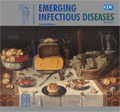
For monitoring efficacy of sulfadoxine/pyrimethamine intermittent preventive treatment for malaria during pregnancy, data obtained from studies of children seemed inadequate. High prevalence of triple and quadruple mutants in the dihydropteroate synthase and dihydrofolate reductase genes of Plasmodium falciparum parasites contrasts with the efficacy of sulfadoxine/pyrimethamine in reducing low birthweights and placental infection rates. In light of this discrepancy, emphasis on using molecular markers for monitoring efficacy of intermittent preventive treatment during pregnancy appears questionable. The World Health Organization recently proposed conducting in vivo studies in pregnant women to evaluate molecular markers for detecting resistance precociously. Other possible alternative strategies are considered.
| EID | Deloron P, Bertin G, Briand V, Massougbodji A, Cot M. Sulfadoxine/Pyrimethamine Intermittent Preventive Treatment for Malaria during Pregnancy. Emerg Infect Dis. 2010;16(11):1666-1670. https://doi.org/10.3201/eid1611.101064 |
|---|---|
| AMA | Deloron P, Bertin G, Briand V, et al. Sulfadoxine/Pyrimethamine Intermittent Preventive Treatment for Malaria during Pregnancy. Emerging Infectious Diseases. 2010;16(11):1666-1670. doi:10.3201/eid1611.101064. |
| APA | Deloron, P., Bertin, G., Briand, V., Massougbodji, A., & Cot, M. (2010). Sulfadoxine/Pyrimethamine Intermittent Preventive Treatment for Malaria during Pregnancy. Emerging Infectious Diseases, 16(11), 1666-1670. https://doi.org/10.3201/eid1611.101064. |
Coccidioidomycosis is endemic to the southwestern United States; 60% of nationally reported cases occur in Arizona. Although the Council of State and Territorial Epidemiologists case definition for coccidioidomycosis requires laboratory and clinical criteria, Arizona uses only laboratory criteria. To validate this case definition and characterize the effects of coccidioidomycosis in Arizona, we interviewed every tenth case-patient with coccidioidomycosis reported during January 2007–February 2008. Of 493 patients interviewed, 44% visited the emergency department, and 41% were hospitalized. Symptoms lasted a median of 120 days. Persons aware of coccidioidomycosis before seeking healthcare were more likely to receive an earlier diagnosis than those unaware of the disease (p = 0.04) and to request testing for Coccidioides spp. (p = 0.05). These findings warrant greater public and provider education. Ninety-five percent of patients interviewed met the Council of State and Territorial Epidemiologists clinical case definition, validating the Arizona laboratory-based case definition for surveillance in a coccidiodomycosis-endemic area.
| EID | Tsang CA, Anderson SM, Imholte SB, Erhart LM, Chen S, Park BJ, et al. Enhanced Surveillance of Coccidioidomycosis, Arizona, USA, 2007–2008. Emerg Infect Dis. 2010;16(11):1738-1744. https://doi.org/10.3201/eid1611.100475 |
|---|---|
| AMA | Tsang CA, Anderson SM, Imholte SB, et al. Enhanced Surveillance of Coccidioidomycosis, Arizona, USA, 2007–2008. Emerging Infectious Diseases. 2010;16(11):1738-1744. doi:10.3201/eid1611.100475. |
| APA | Tsang, C. A., Anderson, S. M., Imholte, S. B., Erhart, L. M., Chen, S., Park, B. J....Sunenshine, R. H. (2010). Enhanced Surveillance of Coccidioidomycosis, Arizona, USA, 2007–2008. Emerging Infectious Diseases, 16(11), 1738-1744. https://doi.org/10.3201/eid1611.100475. |
Volume 16, Number 10—October 2010
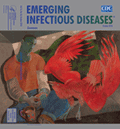
Bloodstream infections (BSIs) are a major cause of illness in HIV-infected persons. To evaluate prevalence of and risk factors for BSIs in 2,009 HIV-infected outpatients in Cambodia, Thailand, and Vietnam, we performed a single Myco/F Lytic blood culture. Fifty-eight (2.9%) had a clinically significant BSI (i.e., a blood culture positive for an organism known to be a pathogen). Mycobacterium tuberculosis accounted for 31 (54%) of all BSIs, followed by fungi (13 [22%]) and bacteria (9 [16%]). Of patients for whom data were recorded about antiretroviral therapy, 0 of 119 who had received antiretroviral therapy for >14 days had a BSI, compared with 3% of 1,801 patients who had not. In multivariate analysis, factors consistently associated with BSI were fever, low CD4+ T-lymphocyte count, abnormalities on chest radiograph, and signs or symptoms of abdominal illness. For HIV-infected outpatients with these risk factors, clinicians should place their highest priority on diagnosing tuberculosis.
| EID | Varma JK, McCarthy KD, Tasaneeyapan T, Monkongdee P, Kimerling ME, Buntheoun E, et al. Bloodstream Infections among HIV-Infected Outpatients, Southeast Asia. Emerg Infect Dis. 2010;16(10):1569-1575. https://doi.org/10.3201/eid1610.091686 |
|---|---|
| AMA | Varma JK, McCarthy KD, Tasaneeyapan T, et al. Bloodstream Infections among HIV-Infected Outpatients, Southeast Asia. Emerging Infectious Diseases. 2010;16(10):1569-1575. doi:10.3201/eid1610.091686. |
| APA | Varma, J. K., McCarthy, K. D., Tasaneeyapan, T., Monkongdee, P., Kimerling, M. E., Buntheoun, E....Cain, K. P. (2010). Bloodstream Infections among HIV-Infected Outpatients, Southeast Asia. Emerging Infectious Diseases, 16(10), 1569-1575. https://doi.org/10.3201/eid1610.091686. |
Nontuberculous mycobacteria (NTM) disease is a notifiable condition in Queensland, Australia. Mycobacterial isolates that require species identification are forwarded to the Queensland Mycobacterial Reference Laboratory, providing a central opportunity to capture statewide data on the epidemiology of NTM disease. We compared isolates obtained in 1999 and 2005 and used data from the Queensland notification scheme to report the clinical relevance of these isolates. The incidence of notified cases of clinically significant pulmonary disease rose from 2.2 (1999) to 3.2 (2005) per 100,000 population. The pattern of disease has changed from predominantly cavitary disease in middle-aged men who smoke to fibronodular disease in elderly women. Mycobacterium intracellulare is the main pathogen associated with the increase in isolates speciated in Queensland.
| EID | Thomson RM. Changing Epidemiology of Pulmonary Nontuberculous Mycobacteria Infections. Emerg Infect Dis. 2010;16(10):1576-1583. https://doi.org/10.3201/eid1610.091201 |
|---|---|
| AMA | Thomson RM. Changing Epidemiology of Pulmonary Nontuberculous Mycobacteria Infections. Emerging Infectious Diseases. 2010;16(10):1576-1583. doi:10.3201/eid1610.091201. |
| APA | Thomson, R. M. (2010). Changing Epidemiology of Pulmonary Nontuberculous Mycobacteria Infections. Emerging Infectious Diseases, 16(10), 1576-1583. https://doi.org/10.3201/eid1610.091201. |
Volume 16, Number 9—September 2010

Chronic granulomatous disease (CGD) is characterized by frequent infections, most of which are curable. Granulibacter bethesdensis is an emerging pathogen in patients with CGD that causes fever and necrotizing lymphadenitis. However, unlike typical CGD organisms, this organism can cause relapse after clinical quiescence. To better define whether infections were newly acquired or recrudesced, we use comparative bacterial genomic hybridization to characterize 11 isolates obtained from 5 patients with CGD from North and Central America. Genomic typing showed that 3 patients had recurrent infection months to years after apparent clinical cure. Two patients were infected with the same strain as previously isolated, and 1 was infected with a genetically distinct strain. This organism is multidrug resistant, and therapy required surgery and combination antimicrobial drugs, including long-term ceftriaxone. G. bethesdensis causes necrotizing lymphadenitis in CGD, which may recur or relapse.
| EID | Greenberg DE, Shoffner AR, Zelazny AM, Fenster ME, Zarember KA, Stock F, et al. Recurrent Granulibacter bethesdensis Infections and Chronic Granulomatous Disease. Emerg Infect Dis. 2010;16(9):1341-1348. https://doi.org/10.3201/eid1609.091800 |
|---|---|
| AMA | Greenberg DE, Shoffner AR, Zelazny AM, et al. Recurrent Granulibacter bethesdensis Infections and Chronic Granulomatous Disease. Emerging Infectious Diseases. 2010;16(9):1341-1348. doi:10.3201/eid1609.091800. |
| APA | Greenberg, D. E., Shoffner, A. R., Zelazny, A. M., Fenster, M. E., Zarember, K. A., Stock, F....Holland, S. M. (2010). Recurrent Granulibacter bethesdensis Infections and Chronic Granulomatous Disease. Emerging Infectious Diseases, 16(9), 1341-1348. https://doi.org/10.3201/eid1609.091800. |
To assess the association of illicit drug use and USA300 methicillin-resistant Staphylococcus aureus (MRSA) bacteremia, a multicenter study was conducted at 4 Veterans Affairs medical centers during 2004–2008. The study showed that users of illicit drugs were more likely to have USA300 MRSA bacteremia (in contrast to bacteremia caused by other S. aureus strains) than were patients who did not use illicit drugs (adjusted relative risk 3.0; 95% confidence interval 1.9–4.4). The association of illicit drug use with USA300 MRSA bacteremia decreased over time (p = 0.23 for trend). Notably, the proportion of patients with USA300 MRSA bacteremia who did not use illicit drugs increased over time. This finding suggests that this strain has spread from users of illicit drugs to other populations.
| EID | Kreisel KM, Johnson J, Stine O, Shardell MD, Perencevich EN, Lesse AJ, et al. Illicit Drug Use and Risk for USA300 Methicillin-Resistant Staphylococcus aureus Infections with Bacteremia. Emerg Infect Dis. 2010;16(9):1419-1427. https://doi.org/10.3201/eid1609.091802 |
|---|---|
| AMA | Kreisel KM, Johnson J, Stine O, et al. Illicit Drug Use and Risk for USA300 Methicillin-Resistant Staphylococcus aureus Infections with Bacteremia. Emerging Infectious Diseases. 2010;16(9):1419-1427. doi:10.3201/eid1609.091802. |
| APA | Kreisel, K. M., Johnson, J., Stine, O., Shardell, M. D., Perencevich, E. N., Lesse, A. J....Roghmann, M. (2010). Illicit Drug Use and Risk for USA300 Methicillin-Resistant Staphylococcus aureus Infections with Bacteremia. Emerging Infectious Diseases, 16(9), 1419-1427. https://doi.org/10.3201/eid1609.091802. |
Volume 16, Number 8—August 2010
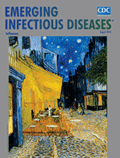
To determine clinical characteristics and outcome of patients with Clostridium difficile bacteremia (CDB), we identified 12 patients with CDB in 2 medical centers in Taiwan; all had underlying systemic diseases. Five had gastrointestinal diseases or conditions, including pseudomembranous colitis (2 patients); 4 recalled diarrhea, but only 5 had recent exposure to antimicrobial drugs. Ten available isolates were susceptible to metronidazole and vancomycin. Five isolates had C. difficile toxin A or B. Of 5 patients who died, 3 died of CDB. Of 8 patients treated with metronidazole or vancomycin, only 1 died, and all 4 patients treated with other drugs died (12.5% vs. 100%; p = 0.01). C. difficile bacteremia, although uncommon, is thus associated with substaintial illness and death rates.
| EID | Lee N, Huang Y, Hsueh P, Ko W. Clostridium difficile Bacteremia, Taiwan. Emerg Infect Dis. 2010;16(8):1204-1210. https://doi.org/10.3201/eid1608.100064 |
|---|---|
| AMA | Lee N, Huang Y, Hsueh P, et al. Clostridium difficile Bacteremia, Taiwan. Emerging Infectious Diseases. 2010;16(8):1204-1210. doi:10.3201/eid1608.100064. |
| APA | Lee, N., Huang, Y., Hsueh, P., & Ko, W. (2010). Clostridium difficile Bacteremia, Taiwan. Emerging Infectious Diseases, 16(8), 1204-1210. https://doi.org/10.3201/eid1608.100064. |
Pandemic (H1N1) 2009 virus causes severe illness, including pneumonia, which leads to hospitalization and even death. To characterize the kinetic changes in viral load and identify factors of influence, we analyzed variables that could potentially influence the viral shedding time in a hospital-based cohort of 1,052 patients. Viral load was inversely correlated with number of days after the onset of fever and was maintained at a high level over the first 3 days. Patients with pneumonia had higher viral loads than those with bronchitis or upper respiratory tract infection. Median viral shedding time after the onset of symptoms was 9 days. Patients <13 years of age had a longer median viral shedding time than those >13 years of age (11 days vs. 7 days). These results suggest that younger children may require a longer isolation period and that patients with pneumonia may require treatment that is more aggressive than standard therapy for pandemic (H1N1) 2009 virus.
| EID | Li C, Wang L, Eng H, You H, Chang L, Tang K, et al. Correlation of Pandemic (H1N1) 2009 Viral Load with Disease Severity and Prolonged Viral Shedding in Children. Emerg Infect Dis. 2010;16(8):1265-1272. https://doi.org/10.3201/eid1608.091918 |
|---|---|
| AMA | Li C, Wang L, Eng H, et al. Correlation of Pandemic (H1N1) 2009 Viral Load with Disease Severity and Prolonged Viral Shedding in Children. Emerging Infectious Diseases. 2010;16(8):1265-1272. doi:10.3201/eid1608.091918. |
| APA | Li, C., Wang, L., Eng, H., You, H., Chang, L., Tang, K....Yang, K. D. (2010). Correlation of Pandemic (H1N1) 2009 Viral Load with Disease Severity and Prolonged Viral Shedding in Children. Emerging Infectious Diseases, 16(8), 1265-1272. https://doi.org/10.3201/eid1608.091918. |
Volume 16, Number 7—July 2010
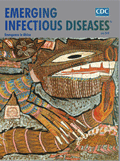
Drug resistance in malaria and in tuberculosis (TB) are major global health problems. Although the terms multidrug-resistant TB and extensively drug-resistant TB are precisely defined, the term multidrug resistance is often loosely used when discussing malaria. Recent declines in the clinical effectiveness of antimalarial drugs, including artemisinin-based combination therapy, have prompted the need to revise the definitions of and/or to recategorize antimalarial drug resistance to include extensively drug-resistant malaria. Applying precise case definitions to different levels of drug resistance in malaria and TB is useful for individual patient care and for public health.
| EID | Wongsrichanalai C, Varma JK, Juliano JJ, Kimerling ME, MacArthur JR. Extensive Drug Resistance in Malaria and Tuberculosis. Emerg Infect Dis. 2010;16(7):1063-1067. https://doi.org/10.3201/eid1607.091840 |
|---|---|
| AMA | Wongsrichanalai C, Varma JK, Juliano JJ, et al. Extensive Drug Resistance in Malaria and Tuberculosis. Emerging Infectious Diseases. 2010;16(7):1063-1067. doi:10.3201/eid1607.091840. |
| APA | Wongsrichanalai, C., Varma, J. K., Juliano, J. J., Kimerling, M. E., & MacArthur, J. R. (2010). Extensive Drug Resistance in Malaria and Tuberculosis. Emerging Infectious Diseases, 16(7), 1063-1067. https://doi.org/10.3201/eid1607.091840. |
Volume 16, Number 6—June 2010

We report 2 patients with invasive aspergillosis after infection with pandemic (H1N1) 2009. Influenza viruses are known to cause immunologic defects and impair ciliary clearance. These defects, combined with high-dose corticosteroids prescribed during influenza-associated adult respiratory distress syndrome, may be novel risk factors predisposing otherwise immunocompetent patients to invasive aspergillosis.
| EID | Lat A, Bhadelia N, Miko B, Furuya EY, Thompson GR. Invasive Aspergillosis after Pandemic (H1N1) 2009. Emerg Infect Dis. 2010;16(6):971-973. https://doi.org/10.3201/eid1606.100165 |
|---|---|
| AMA | Lat A, Bhadelia N, Miko B, et al. Invasive Aspergillosis after Pandemic (H1N1) 2009. Emerging Infectious Diseases. 2010;16(6):971-973. doi:10.3201/eid1606.100165. |
| APA | Lat, A., Bhadelia, N., Miko, B., Furuya, E. Y., & Thompson, G. R. (2010). Invasive Aspergillosis after Pandemic (H1N1) 2009. Emerging Infectious Diseases, 16(6), 971-973. https://doi.org/10.3201/eid1606.100165. |
Volume 16, Number 5—May 2010
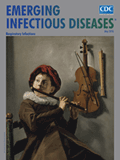
Tropheryma whipplei, which causes Whipple disease, is found in human feces and may cause gastroenteritis. To show that T. whipplei causes gastroenteritis, PCRs for T. whipplei were conducted with feces from children 2–4 years of age. Western blotting was performed for samples from children with diarrhea who had positive or negative results for T. whipplei. T. whipplei was found in samples from 36 (15%) of 241 children with gastroenteritis and associated with other diarrheal pathogens in 13 (33%) of 36. No positive specimen was detected for controls of the same age (0/47; p = 0.008). Bacterial loads in case-patients were as high as those in patients with Whipple disease and significantly higher than those in adult asymptomatic carriers (p = 0.002). High incidence in patients and evidence of clonal circulation suggests that some cases of gastroenteritis are caused or exacerbated by T. whipplei, which may be co-transmitted with other intestinal pathogens.
| EID | Raoult D, Fenollar F, Rolain J, Minodier P, Bosdure E, Li W, et al. Tropheryma whipplei in Children with Gastroenteritis. Emerg Infect Dis. 2010;16(5):776-782. https://doi.org/10.3201/eid1605.091801 |
|---|---|
| AMA | Raoult D, Fenollar F, Rolain J, et al. Tropheryma whipplei in Children with Gastroenteritis. Emerging Infectious Diseases. 2010;16(5):776-782. doi:10.3201/eid1605.091801. |
| APA | Raoult, D., Fenollar, F., Rolain, J., Minodier, P., Bosdure, E., Li, W....Richet, H. (2010). Tropheryma whipplei in Children with Gastroenteritis. Emerging Infectious Diseases, 16(5), 776-782. https://doi.org/10.3201/eid1605.091801. |
Volume 16, Number 4—April 2010

Virulent community-associated methicillin-resistant Staphylococcus-aureus (CA-MRSA) strains have spread rapidly in the United States. To characterize the degree to which CA-MRSA strains are imported into and transmitted in pediatric intensive care units (PICU), we performed a retrospective study of children admitted to The Johns Hopkins Hospital PICU, March 1, 2007–May 31, 2008. We found that 72 (6%) of 1,674 PICU patients were colonized with MRSA. MRSA-colonized patients were more likely to be younger (median age 3 years vs. 5 years; p = 0.02) and African American (p<0.001) and to have been hospitalized within 12 months (p<0.001) than were noncolonized patients. MRSA isolates from 66 (92%) colonized patients were fingerprinted; 40 (61%) were genotypically CA-MRSA strains. CA-MRSA strains were isolated from 50% of patients who became colonized with MRSA and caused the only hospital-acquired MRSA catheter-associated bloodstream infection in the cohort. Epidemic CA-MRSA strains are becoming endemic to PICUs, can be transmitted to hospitalized children, and can cause invasive hospital-acquired infections. Further appraisal of MRSA control is needed.
| EID | Milstone AM, Carroll KC, Ross T, Shangraw KA, Perl TM. Community-associated Methicillin-Resistant Staphylococcus aureus Strains in Pediatric Intensive Care Unit. Emerg Infect Dis. 2010;16(4):647-655. https://doi.org/10.3201/eid1604.090107 |
|---|---|
| AMA | Milstone AM, Carroll KC, Ross T, et al. Community-associated Methicillin-Resistant Staphylococcus aureus Strains in Pediatric Intensive Care Unit. Emerging Infectious Diseases. 2010;16(4):647-655. doi:10.3201/eid1604.090107. |
| APA | Milstone, A. M., Carroll, K. C., Ross, T., Shangraw, K. A., & Perl, T. M. (2010). Community-associated Methicillin-Resistant Staphylococcus aureus Strains in Pediatric Intensive Care Unit. Emerging Infectious Diseases, 16(4), 647-655. https://doi.org/10.3201/eid1604.090107. |
Volume 16, Number 3—March 2010

The yield from aspirating lymph nodes and pleural fluid for diagnosing extensively drug-resistant (XDR) tuberculosis is unknown. Mycobacterium tuberculosis was cultured from lymph node or pleural fluid aspirates of 21 patients; 7 (33%) cultures grew XDR M. tuberculosis. Additive diagnostic yield for XDR M. tuberculosis was found in parallel culture of sputum and fluid aspirate.
| EID | Heysell SK, Moll AP, Gandhi NR, Eksteen FJ, Babaria P, Coovadia Y, et al. Extensively Drug-Resistant Mycobacterium tuberculosis from Aspirates, Rural South Africa. Emerg Infect Dis. 2010;16(3):557-560. https://doi.org/10.3201/eid1603.091486 |
|---|---|
| AMA | Heysell SK, Moll AP, Gandhi NR, et al. Extensively Drug-Resistant Mycobacterium tuberculosis from Aspirates, Rural South Africa. Emerging Infectious Diseases. 2010;16(3):557-560. doi:10.3201/eid1603.091486. |
| APA | Heysell, S. K., Moll, A. P., Gandhi, N. R., Eksteen, F. J., Babaria, P., Coovadia, Y....Shah, N. (2010). Extensively Drug-Resistant Mycobacterium tuberculosis from Aspirates, Rural South Africa. Emerging Infectious Diseases, 16(3), 557-560. https://doi.org/10.3201/eid1603.091486. |
Volume 16, Number 2—February 2010
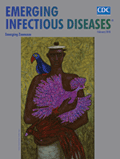
We determined estimated incidence of and risk factors for community-associated Clostridium difficile infection (CA-CDI) among patients treated at 6 North Carolina hospitals. CA-CDI case-patients were defined as adults (>18 years of age) with a positive stool test result for C. difficile toxin and no hospitalization within the prior 8 weeks. CA-CDI incidence was 21 and 46 per 100,000 person-years in Veterans Affairs (VA) outpatients and Durham County populations, respectively. VA case-patients were more likely than controls to have received antimicrobial drugs (adjusted odds ratio [aOR] 17.8, 95% confidence interval [CI] 6.6–48] and to have had a recent outpatient visit (aOR 5.1, 95% CI 1.5–17.9). County case-patients were more likely than controls to have received antimicrobial drugs (aOR 9.1, 95% CI 2.9–28.9), to have gastroesophageal reflux disease (aOR 11.2, 95% CI 1.9–64.2), and to have cardiac failure (aOR 3.8, 95% CI 1.1–13.7). Risk factors for CA-CDI overlap with those for healthcare-associated infection.
| EID | Kutty PK, Woods CW, Sena AC, Benoit SR, Naggie S, Frederick J, et al. Risk Factors for and Estimated Incidence of Community-associated Clostridium difficile Infection, North Carolina, USA. Emerg Infect Dis. 2010;16(2):198-204. https://doi.org/10.3201/eid1602.090953 |
|---|---|
| AMA | Kutty PK, Woods CW, Sena AC, et al. Risk Factors for and Estimated Incidence of Community-associated Clostridium difficile Infection, North Carolina, USA. Emerging Infectious Diseases. 2010;16(2):198-204. doi:10.3201/eid1602.090953. |
| APA | Kutty, P. K., Woods, C. W., Sena, A. C., Benoit, S. R., Naggie, S., Frederick, J....McDonald, L. C. (2010). Risk Factors for and Estimated Incidence of Community-associated Clostridium difficile Infection, North Carolina, USA. Emerging Infectious Diseases, 16(2), 198-204. https://doi.org/10.3201/eid1602.090953. |
Volume 16, Number 1—January 2010
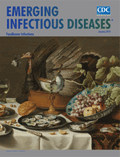
Microbiologic infections acquired from animals, known as zoonoses, pose a risk to public health. An estimated 60% of emerging human pathogens are zoonotic. Of these pathogens, >71% have wildlife origins. These pathogens can switch hosts by acquiring new genetic combinations that have altered pathogenic potential or by changes in behavior or socioeconomic, environmental, or ecologic characteristics of the hosts. We discuss causal factors that influence the dynamics associated with emergence or reemergence of zoonoses, particularly in the industrialized world, and highlight selected examples to provide a comprehensive view of their range and diversity.
| EID | Cutler SJ, Fooks AR, van der Poel WH. Public Health Threat of New, Reemerging, and Neglected Zoonoses in the Industrialized World. Emerg Infect Dis. 2010;16(1):1-7. https://doi.org/10.3201/eid1601.081467 |
|---|---|
| AMA | Cutler SJ, Fooks AR, van der Poel WH. Public Health Threat of New, Reemerging, and Neglected Zoonoses in the Industrialized World. Emerging Infectious Diseases. 2010;16(1):1-7. doi:10.3201/eid1601.081467. |
| APA | Cutler, S. J., Fooks, A. R., & van der Poel, W. H. (2010). Public Health Threat of New, Reemerging, and Neglected Zoonoses in the Industrialized World. Emerging Infectious Diseases, 16(1), 1-7. https://doi.org/10.3201/eid1601.081467. |
CME Articles by Volume




